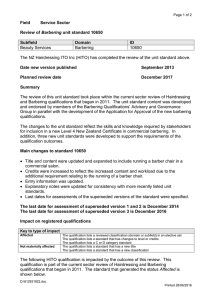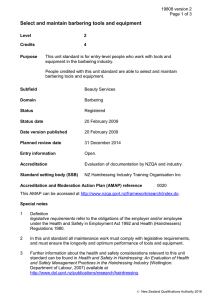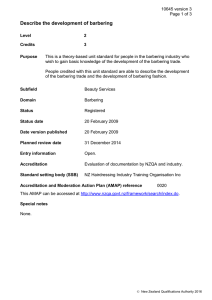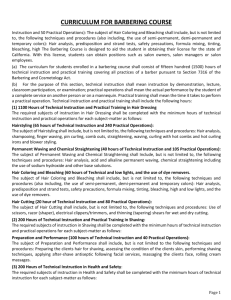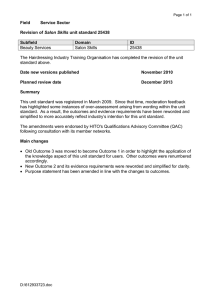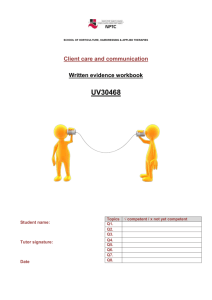NZQA registered unit standard 10650 version 4 Page 1 of 4
advertisement
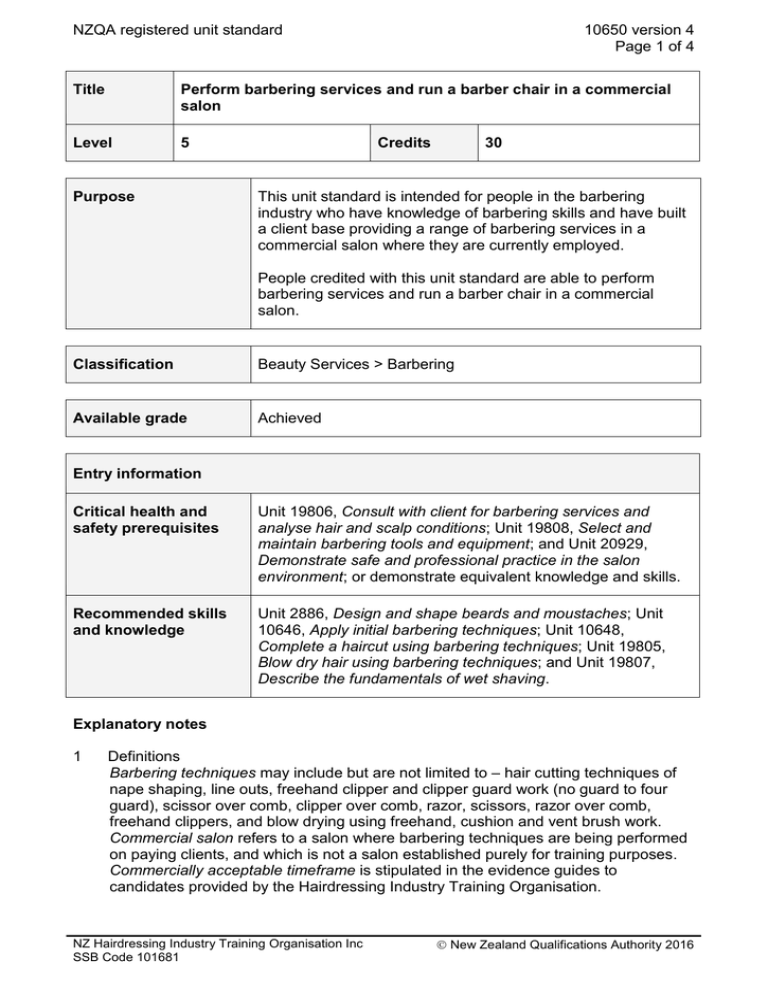
NZQA registered unit standard 10650 version 4 Page 1 of 4 Title Perform barbering services and run a barber chair in a commercial salon Level 5 Purpose Credits 30 This unit standard is intended for people in the barbering industry who have knowledge of barbering skills and have built a client base providing a range of barbering services in a commercial salon where they are currently employed. People credited with this unit standard are able to perform barbering services and run a barber chair in a commercial salon. Classification Beauty Services > Barbering Available grade Achieved Entry information Critical health and safety prerequisites Unit 19806, Consult with client for barbering services and analyse hair and scalp conditions; Unit 19808, Select and maintain barbering tools and equipment; and Unit 20929, Demonstrate safe and professional practice in the salon environment; or demonstrate equivalent knowledge and skills. Recommended skills and knowledge Unit 2886, Design and shape beards and moustaches; Unit 10646, Apply initial barbering techniques; Unit 10648, Complete a haircut using barbering techniques; Unit 19805, Blow dry hair using barbering techniques; and Unit 19807, Describe the fundamentals of wet shaving. Explanatory notes 1 Definitions Barbering techniques may include but are not limited to – hair cutting techniques of nape shaping, line outs, freehand clipper and clipper guard work (no guard to four guard), scissor over comb, clipper over comb, razor, scissors, razor over comb, freehand clippers, and blow drying using freehand, cushion and vent brush work. Commercial salon refers to a salon where barbering techniques are being performed on paying clients, and which is not a salon established purely for training purposes. Commercially acceptable timeframe is stipulated in the evidence guides to candidates provided by the Hairdressing Industry Training Organisation. NZ Hairdressing Industry Training Organisation Inc SSB Code 101681 New Zealand Qualifications Authority 2016 NZQA registered unit standard 10650 version 4 Page 2 of 4 Commercially acceptable timeframes vary for different barbering services. Times reflect performance required for the economic viability of a trading salon. Commercially viable client base is one that ensures that sufficient income is generated from barbering services to cover the cost of the barber’s hourly wage and salon overheads. Contemporary styles refer to up-to-date cuts that reflect current or emerging trends in barbering. Critically analyse means to not only analyse the hair and scalp, but to evaluate what services are possible for the client with consideration to health and safety factors, potential outcome and client’s expectations. Integrated barbering techniques refer to the innovative use of one or more barbering techniques within a single haircut and/or beard trim to achieve advanced or complex styles. Legislative requirements refer to industry and legislative requirements contained in: Sections 6 and 7 of the Health (Hairdressers) Regulations 1980; NZ Association of Hairdressers Inc., Guide to Occupational Safety and Health for the Hairdressing Industry (Auckland, 1997) available at http://www.osh.dol.govt.nz/order/catalogue/#oc Material Safety Data Sheets (MSDSs); Privacy Act 1993, Health and Safety in Employment Act 1992, Human Rights Act 1993, Smoke-free Environments Act 1990, and subsequent amendments, Fire Safety and Evacuation of Buildings Regulations 2006, and enterprise fire and emergency policies and procedures. Salon refers to a barber shop or salon that is registered under the Health (Registration of Premises) Regulations 1966. 2 In this unit standard all work must comply with legislative requirements and must ensure optimum hair condition and maximum client comfort at all times. 3 Industry standards are listed in Hairdressing & Barbering Industry Standards at http://www.hito.org.nz. 4 Sanitisation of tools and equipment, and cleaning of the workstation, carried out throughout the services performed, is in accordance with legislative requirements. 5 Range The performance of barbering services and the running of a barber chair must be demonstrated over a continuous period of four weeks. Outcomes and evidence requirements Outcome 1 Perform barbering services in a commercial salon. Evidence requirements 1.1 Consultation is undertaken to identify and critically analyse client requirements, and a course of action that meets those requirements is determined and mutually agreed with every client. NZ Hairdressing Industry Training Organisation Inc SSB Code 101681 New Zealand Qualifications Authority 2016 NZQA registered unit standard Range 1.2 the style and depth of consultation may vary for each client, but must be appropriate to ensure that every client’s requirements are accurately identified and analysed. Integrated barbering techniques are used to achieve contemporary styles that fulfil the agreed course of action, in accordance with industry standards and legislative requirements. Range 1.3 10650 version 4 Page 3 of 4 evidence of integrated barbering techniques on at least three different clients is required. Barbering services are completed in a commercially acceptable timeframe. Outcome 2 Run a barber chair in a commercial salon. Evidence requirements 2.1 A commercially viable client base is serviced to meet the agreed course of action for every client, in accordance with industry standards, and client and legislative requirements. 2.2 Tasks related to running the barber chair are prioritised and completed to meet industry standards and client and salon requirements. may include but is not limited to – reception and administration duties, preparing takings for banking, selling products, supervision of staff, sanitation of tools, safety of work area; client requirements may include but are not limited to – client expectations, client comfort. Range 2.3 Tasks related to running the barber chair are completed in a commercially acceptable timeframe. Planned review date 31 December 2017 Status information and last date for assessment for superseded versions Process Version Date Last Date for Assessment Registration 1 28 April 1997 31 December 2014 Revision 2 16 January 2003 31 December 2014 Review 3 25 October 2005 31 December 2016 Review 4 19 September 2013 N/A Consent and Moderation Requirements (CMR) reference 0020 This CMR can be accessed at http://www.nzqa.govt.nz/framework/search/index.do. NZ Hairdressing Industry Training Organisation Inc SSB Code 101681 New Zealand Qualifications Authority 2016 NZQA registered unit standard 10650 version 4 Page 4 of 4 Please note Providers must be granted consent to assess against standards (accredited) by NZQA, before they can report credits from assessment against unit standards or deliver courses of study leading to that assessment. Industry Training Organisations must be granted consent to assess against standards by NZQA before they can register credits from assessment against unit standards. Providers and Industry Training Organisations, which have been granted consent and which are assessing against unit standards must engage with the moderation system that applies to those standards. Requirements for consent to assess and an outline of the moderation system that applies to this standard are outlined in the Consent and Moderation Requirements (CMR). The CMR also includes useful information about special requirements for organisations wishing to develop education and training programmes, such as minimum qualifications for tutors and assessors, and special resource requirements. Comments on this unit standard Please contact the NZ Hairdressing Industry Training Organisation Inc enquiries@hito.org.nz if you wish to suggest changes to the content of this unit standard. NZ Hairdressing Industry Training Organisation Inc SSB Code 101681 New Zealand Qualifications Authority 2016
